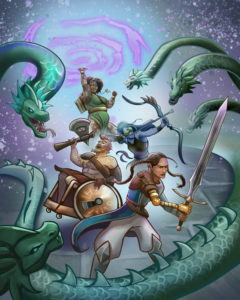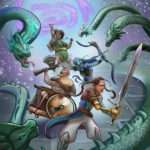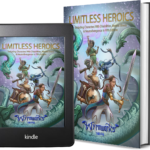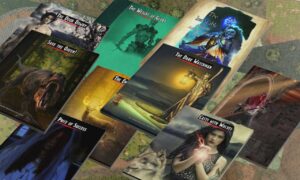Limitless Heroics Introduction
Including Characters with Disabilities, Mental Illness, and Neurodivergence in fifth edition
In loving memory of my dad, Bill Critchley
You always told me how proud you were of me,
But you will always be my hero.
Making Lives Better through Roleplaying Games
This book is one piece of the beginning of a movement within the roleplaying game (RPG) community to invite, encourage, and include those who have not been, both in the RPG community and nearly everywhere in real life. Wyrmworks Publishing is dedicated to using Tabletop RPGs (TTRPGs) to help you make lives better, and to provide tools, training, and a community to this end. We believe that this effort will extend far beyond the ever-growing RPG community as more and more people learn, grow, and give and receive acceptance. If you want to help make that happen, we invite you to support the Wyrmworks Publishing Patreon at https://patreon.com/wyrmworkspublishing and enjoy the additional benefits we offer to our patrons.
We built a random disability generator based on this book at generate.inclusiverpg.com. While you’re there, sign up for our free newsletter to get free content, exclusive extras for this book, discounts, and other offers.
100% of content creators hired for this book are disabled, neurodivergent, and/or have mental or chronic illness, and the variety of art styles intentionally reflects the diversity of experiences and expressions of these conditions.
About the Cover
Our heroes fighting the hydra represent only some of the variety of traits in this book. The paladin has a Arm & Hand Item to assist with their amputation. The barbarian rages from their wheelchair, mobile without needing to rely on their legs. The ranger, more accustomed to an aquatic environment just as someone in the real world may be more comfortable in a quieter or darker sensory environment, finds ways to compensate and keep fighting using sensory filtering devices. The wizard’s vitiligo may not be thought of as a disability, nor should it be, yet many in the real world experience severe discrimination due to unusual skin pigment — how many celebrities, corporate executives, or politicians do you know with visibly irregular skin?
Content Warning
This book contains descriptions and game mechanics for nearly every physical, mental, and emotional trait in existence and a few that don’t exist. These descriptions include trauma and all manner of illnesses, including an entry on phobias and mention or illustrations of possible phobic triggers. If it can happen to your mind and/or body, it’s probably here. For those who would have difficulty with any of that, please be aware of that likelihood. Make careful use of the table of contents or give this book to a trusted friend and let them comb through it for the details you need to build your character while skipping past the traumatic entries.
Welcome! No, seriously, you’re welcome here.
The 2020 release of Sara Thompson’s Combat Wheelchair and Jennifer Kretchmer’s adventure in Candlekeep Mysteries sparked a conversation throughout the RPG community about disabilities, ableism, and accessibility, bringing awareness to a relatively ignored but huge global minority.
While I don’t identify as disabled, I do find myself in over a half dozen physical, mental, and neurodiverse traits in this book. I have a Bachelor of Arts in psychology, and I’ve cared for people with disabilities for decades, including working in an orthotics shop in college and as a counselor at a camp with developmentally disabled campers. I have also worked with teens with disabilities and mental illness as a youth pastor, was recently employed as a Direct Service Provider in a group home, and am a father of children with disabilities, neurodiversity, and mental illness. I want the disabled people I love not just to find characters like them in an RPG, but I also want others who might not encounter many disabled people in their own lives to have a chance to experience and interact with disabled people through roleplaying to help them feel comfortable when they encounter them in real life.
The process of writing this book included consultations and conversations with multiple disabled, neurodivergent, and mentally ill people who shared their experiences and feedback to provide proper representation. But feedback on hundreds of traits — some of which correspond to rare conditions — was impossible, so to that end, we continue to hear those experiences through our monthly show, Gaining Advantage. We invite our readers to contact us to come on the show and share your experiences as others have.
What This Book Is
If you have ever felt not represented, now is your opportunity!
Jess Butt
This book is a tool to include disabled characters in a fifth edition setting, both as Player Characters (PCs) and Non-Player Characters (NPCs). The book helps the Game Master (GM) and players explore the concept of disability in a fantasy setting, raise awareness of disabled people and communities, and normalize interactions with them. This book assumes familiarity with at least the Basic Rules of the fifth edition of the world’s greatest roleplaying game.
Note that this book is also intended to help people without the book’s traits represent people with them in their games. If we want better representation and less stigma, it helps to encourage it at every gaming table beyond one where the players only represent their own experiences, analogous to female characters in a world at an all-male table or including other populations not currently playing, especially minorities. (See the Asians Represent! Podcast for one example.) We can’t claim to know or to perfectly represent someone else’s experience, but in respectful roleplay, we can attempt to know it a little better today than we did yesterday and thus gain empathy and awareness, which will, in turn, help us interact with those whose experiences vary from ours and better understand how we can support each other and embrace diversity.
What This Book Is Not
This is not a medical journal. While real-world examples of disabilities are listed for disabled players looking for representation and to help educate players, these are fantasy disabilities designed to work within the rules of fifth edition in a fantasy world. They are not intended to be exact duplicates of real-world disabilities. Real-world terminology for traits, where used, is for convenience, not clinical accuracy. Do not use this as WebMD&D to self-diagnose.
This book breaks disabilities down into traits, rather than the collections that comprise real-world disorders. We made this choice for many reasons. First, most disorders include a range of possible traits but manifest differently in different people. Many of us have heard the saying, “Autism is a spectrum.” There’s no way a simple game mechanic could encapsulate that variety, while the converse is also true — many disorders have the same traits but differ in their underlying cause, so in game terms, they’re identical. At the same time, nearly all disabled players should be able to find their traits represented here, so if they’d like to play as a character with the same ones, they can use this book like a list of ingredients in a recipe. Also, note that many disabilities and traits don’t fit into a single category, and the categorization here is by presentation rather than cause, grouped more with character creation in mind than scientific accuracy (which is subject to change).
Even with the extensive list of traits included here, it’s impossible to describe every subtle difference from one person’s experience to another’s, as even with the same traits, every experience is unique. We’ve included some sidebars as examples of these variations, but players should consider every entry to be open to variations, and we encourage learning about different experiences.
This book is also not an experience of disability for the player. While it may give players insight into the challenges that some disabled people face, players can, at any time, stop playing the game, setting that imagined disability aside.
Finally, language changes through time, and sometimes there are even disagreements over current terminology (e.g., identity-first vs. person-first language). It is not our intention to use language that offends anyone. Please keep this in mind when using the book if you prefer different terminology, and feel free to use it in place of what is here.
What to avoid
This book is a revelation! It will help everyone who wants to play a disabled character create one with ease and without resorting to harmful tropes. The system is simple, elegant, and very effective. I can’t wait to use this book in my next campaign!
Candace Hoeckley
Certain harmful tropes tend to recur in fictional media that dehumanize and objectify disabled people. Even if a kobold has post-traumatic stress disorder (PTSD), they’re still a person.
Take a moment to consider the character’s disability and how it affects them, even a background NPC. How did they acquire the disability? How long have they had it? Mentally move through a typical day for them, and consider how it’s different from a non-disabled character.
With this in mind, avoid these common themes:
This list is a summary of the articles in Fay Onyx’s Ableist Tropes in Storytelling series. You can find this series, along with many more resources on portraying disability, at https://writingalchemy.net/podcast-2/unfamiliar-heroes/trope-of-the-week-series/
- Villainous Disability. Often, the villain is the only character in the story with a disability. Darth Vader was so defined by his breathing apparatus that, at the door of his redemption arc, he had it removed. If you have villains with disabilities, make sure they’re not the only noticeable disabled characters, and don’t define them by their disability. Likewise, don’t use “insane/crazy” as the villain’s motivation, especially when “crazy” has nothing to do with actual mental illness and is just a lazy motivation for “quirky bully.” If you have a disabled villain, make sure they’re not the only disabled character, and make sure their disability is neither a symbol nor a motivation for their evil.
- Bitter Disability. If the character is bitter, don’t make their bitterness about their disability. The disability can be part of the story that made them bitter, but don’t make it the focus. (Darth Vader is bitter about losing his wife, not about his disability.)
- Cosmetic Disability. If a character has a disability, don’t give them a perfect adaptation that makes their disability meaningless. Luke Skywalker in Star Wars loses a hand but is provided a prosthetic hand that does everything his original hand did without any depiction of the need for maintenance, the hand’s limitations, or any discomfort. The prosthetic is so perfect that it, and Luke’s disability, are meaningless. Consult the adaptations in the Magic Assistance appendix for ways to assist with the disability without minimizing it.
- Helpless Disability. Don’t make the disabled character the one who always needs to be rescued any more than any other characters and avoid predatory plot points that specifically target the character’s disability. Give them challenges that, just like anyone else, they sometimes overcome and sometimes not.
- Inspirational Disability. Don’t dehumanize a character so that their only purpose is to inspire and teach non-disabled people a lesson. (“If they can do this while disabled, you can, too!” or “Aren’t you glad you don’t have that disability?”) Make NPCs complex characters with other features such that their disability is one feature in a list, not a defining characteristic. (Yoda has a mobility disability that requires the use of a cane, but that isn’t his core characteristic.) Make their accomplishments great accomplishments regardless of disability.
- Magical Cures and Disability as an Obstacle. Disability should be depicted as something to be managed, not cured. Adaptations have side-effects and disadvantages that change the way a person gets through each day, makes plans, and relates to the world. The goal of most disabled people is to achieve their dreams while managing their disability, not curing or hiding it from non-disabled people. The next section on the difference between conditions and disabilities discusses this. Finally, consider how a character’s experience changes over time, possibly getting gradually better or worse, but also how their goals don’t focus on their disabilities any more than a fighter’s goal is to overcome the inability to cast spells.
- Fragile Body, Magic Mind. (Yes, Professor X, we’re thinking of you.) When choosing abilities for your fantasy character, consider all possibilities as you would any other character. Yes, physically disabled characters can be casters, but they can also be barbarians, and characters with mental disabilities can be wizards. Choose their class and abilities based on the character concept, not based on the disability.
- One-Dimensional Disability. Don’t have all your disabled characters fit all the majority norms of race, gender, religion, and orientation. How else besides disability are they different from Gandalf, Frodo, and Gimli?
- Metaphorical Disability. Don’t use an oppressed group, including disabled people, as a metaphor for that oppression unless the player is a member of that group and chooses to do so, such as Tiny Tim and his crutch representing poverty and oppression in A Christmas Carol or Captain Hook being both named for and represented by his prosthesis in Peter Pan. If you want to have metaphorical representation in your stories, rather than using humanoid characters as symbols, use objects, animals, or the environment, or use a different feature of the character as the symbol (e.g., red armor or their warlock patron), not their oppressed identity.
- Ableist Monsters. Don’t use disability to make monsters scary or unsettling. Drooling, limping, limb deformities, and other physical and mental features that mimic human disabilities associate those characteristics with fear and evil and affect our perception of real disabled people. Avoid monster abilities that impose “madness” on characters. If a monster has an emotionally upsetting ability, consider describing it as confusing, disorienting, horrifying, distressing, unsettling, or some other synonym for extreme discomfort, and avoid effects that seem to mimic real-world mental illness or stereotypes of the same.
What about the Restoration and Regeneration Spells?
Many have asked, “Why would you have disabilities in a world with the Greater Restoration and Lesser Restoration spells? Why not just heal them?”
First, consider the real-life effect versus the in-game effect. Campaign worlds are designed starting with the real world, then removing and adding features to make it fantasy. When creating a world, why are you removing disabled people from it? Disabilities add depth to a campaign world and benefits to players and GMs by learning about disabilities and living with them.
But even beyond that, what do the rules say? Lesser Restoration “can end either one disease or one condition afflicting [the target]. The condition can be blinded, deafened, paralyzed, or poisoned.” Greater Restoration can “undo a debilitating effect. You can reduce the target’s exhaustion level by one, or end one of the following effects on the target…reduction to one of the target’s ability scores…effect reducing the target’s hit point maximum.”
A condition, as a fifth edition game mechanic, has specific implications. “A condition lasts either until it is countered (the prone condition is countered by standing up, for example) or for a duration specified by the effect that imposed the condition.” Conditions in fifth edition either can be countered or have durations. An injury could result in a condition that will eventually either be countered (healed), end its duration (wear off), or become a disability (See Acquired Disabilities below), but none of the fifth edition conditions are permanent or long-term.
Further, to undo a debilitating effect implies that the effect was done in the first place. For a person born with a congenital condition, nothing was done that can be undone. But even if it’s an effect that happens later, the spell gives specific rules to what effects can be undone, not just any debilitating effect. It can’t undo the debilitating effect of not being able to breathe due to falling one thousand feet and being crushed. Related to disabilities, it only helps with exhaustion (not the cause of the exhaustion unless it’s a disease, for which you can use Lesser Restoration), not chronic pain, anxiety, depression, or most disability traits in this book which do not directly affect ability scores or maximum hit points.
Lesser Restoration can end a disease, but how do you define disease in your game, especially since the rules distinguish between diseases and insanity (fifth edition’s harmful term for mental illness and neurodiversity), and disease is a physical condition caused by a foreign substance interacting with the body detrimentally? This description rules out all forms of mental illness, congenital conditions, and other conditions caused by internal factors. The exceptions may be those specifically listed: blinded, deafened, paralyzed, or poisoned; but even those are specific conditions that refer to Acute (IE 4 in this book) conditions. But again, if the condition is caused by internal biology, it only mitigates the condition, not the cause, which means it will likely return at the same rate as the initial onset or faster unless caused by injury or disease, or if you distinguish between conditions and traits as noted here, these spells only affect (temporary) conditions, not traits, by a strict reading of the rules.
Blindness or Blinded?
While fifth edition includes rules for the blinded condition, as noted here, that condition is temporary and does not reflect the experience of a person with long-term or permanent blindness. This book uses blinded to refer to the condition, and Blind or Blindness to refer to the trait. Likewise, deafened is the temporary condition versus Deaf or Deafness. All references in this book to Paralysis or being Paralyzed refer to the trait, not the condition, unless specifically noted.
Regenerate “stimulate[s a creature’s] natural healing ability” to regrow severed body members, not grow new members that were never there in the first place, so using Regenerate to grow a limb that was never there will be no more effective than trying to “regrow” a tail on an elf or wings on a pig.
Have the Discussion
Talk to your players either during Session Zero, when you first introduce disabled characters, or when you plan to give a player character a disability. Point them to one of the links at the end of this book. Talk about the above tropes. Find out how they feel about it. Note that some players like to have the chance to fight against oppression in-game where they can sometimes feel or be more effective than in the real world (emancipation bleed) while others don’t have the emotional spell slots for this (fatigue diversity) and instead want a world that is very accessible and leaves this conflict behind. Talk about this together, and decide how you’d like to experience representation in your game.
Don’t force it
If a player is uncomfortable playing a character with a disability or chooses not to in the game, the GM [3] should not force this on the player without their consent. If GMs want to give players experiences with disabled people, this can still be done with disabled NPCs. Forcing a player to play a disabled character will only create resentment.
GMs and players should also be sensitive to “body horror” concerns. As difference has been used commonly in the horror genre to elicit fear and disgust, participants should be careful that they avoid eliciting these reactions among other participants, as the goal is to make people comfortable around those with disabilities, not afraid of them. Again, talk to players, individually if necessary, to understand how they feel about specific proposed traits among their own or other characters.
Every one of us encounters disabled people in our lives, and many of us are disabled or will be someday, and including them in our fantasy worlds gives us insights into their experiences, opportunities to explore accessibility, and awareness of ways that we can improve each other’s lives, but know your players enough to determine the most beneficial way to do that. How many, if any, will roleplay a character that experiences a fulfilling life with some added challenges? Will they meet an NPC that they will interact with and depend on? Decide what will be most beneficial at your table.
Don’t fix it
While the disabilities listed offer suggestions for assistive technology, notice that most of the suggestions don’t negate the disability. That’s not how assistive devices usually work. Some assistive devices come close, such as the glasses I wear for nearsightedness and astigmatism, but because they correct my vision to 20/20, I don’t identify as disabled, but even those require maintenance and can fall off. They help compensate but also have drawbacks and limitations. We encourage you to include this in your game.
Learn
When playing a character with specific traits, to get the most benefit, learn more about those real-world traits or, even if playing fantasy traits, the ones they’re based on. Look them up on recognized medical websites or Wikipedia. Even better, find people for whom those traits are part of life who write or speak about their experience. Note that this isn’t always easy, as part of life for a disabled person is explaining their traits ad nauseum to medical professionals, family members, friends, coworkers, and many more, and it’s exhausting. Online communities like Reddit’s r/disability or r/Disabled_dungeons or subreddits dedicated to specific disabilities, websites dedicated to specific disabled communities, or Wyrmworks Publishing’s show, Gaining Advantage, can help you.
At the same time, part of learning is recognizing that you don’t know everything and won’t always get it right. Not to mention that everyone’s experiences with disability, and even the same traits, are different. Be patient with others and yourself. No one should expect you to know everything. I talked to dozens of people about their traits in addition to hundreds of hours of research to write this book, and I welcome the opportunity to learn and grow. You just need to care and value people.
Acknowledge the Inconvenience
Adding these rules, which can sometimes affect every round, may add some inconvenience or even tedium to the game. This is unavoidable but also educational; you may find it adds to the roleplay experience and how you identify with your character and others’. In other words, experiencing these challenges creates empathy for those for whom such challenges are an unavoidable part of their lives.
Choose Your Style
The rules in this book are suggestions — starting points for representation. Players and GMs should discuss any given trait and decide how to roleplay it, whether using the rules in this book as they are, altering or replacing them to better match a lived experience, reduce cognitive load, or avoid emotional triggers, or using the trait(s) to raise awareness while roleplaying the traits purely through descriptions without assigning modifiers but still discussing what benefits and challenges would apply to any given situation.
Note also that every random table says, “Choose or roll,” and the GM and player can decide how to use these tables to their benefit during character creation.







 👀 Get 10 Free Adventures
👀 Get 10 Free Adventures
Comments
Limitless Heroics Introduction — No Comments
HTML tags allowed in your comment: <a href="" title=""> <abbr title=""> <acronym title=""> <b> <blockquote cite=""> <cite> <code> <del datetime=""> <em> <i> <q cite=""> <s> <strike> <strong>